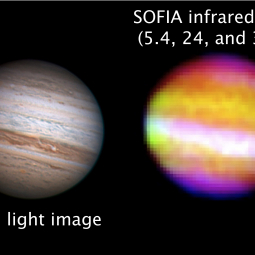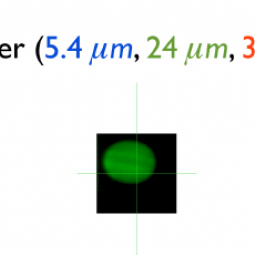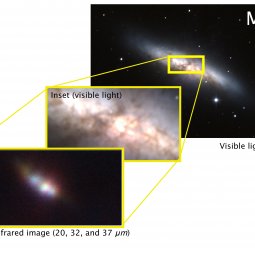The Stratospheric Observatory for Infrared Astronomy (SOFIA), a joint program by NASA and the German Aerospace Center (DLR), achieved a major milestone May 26, 2010, when the airborne observatory made its first in-flight nighttime observations. Astronomers call the first observations by a new observatory “first light.”
"With this flight, SOFIA begins a 20-year journey that will enable a wide variety of astronomical science observations not possible from other Earth- and space-borne observatories," said Jon Morse, NASA's Astrophysics Division director. "It clearly demonstrates that SOFIA will provide us with "Great Observatory"–class astronomical science."
The highly modified Boeing 747SP jetliner, fitted with a 100-inch (2.5-meter) diameter reflecting telescope, took off from NASA’s Dryden Aircraft Operations Facility in Palmdale, Calif. The in-flight personnel consisted of an international crew from NASA, Universities Space Research Association (USRA), the German SOFIA Institute (DSI) and Cornell University, Ithaca, N.Y. During the six-hour flight at altitudes up to 35,000 feet, the crew of 10 scientists, engineers and technicians worked at consoles in the aircraft’s main cabin to gather telescope performance data.
The results, according to NASA SOFIA project scientist Pam Marcum, were gratifying. “Wind tunnel tests and supercomputer calculations made at the start of the SOFIA program predicted we would have sharp enough images for front-line astronomical research; a preliminary look at the first light data indicates we indeed accomplished that,” said Marcum.
The stability and precise pointing of the German-built telescope met or exceeded the expectations of the engineers and astronomers who put it through its paces during the flight.
"The crowning accomplishment of the night came when scientists on board SOFIA recorded images of Jupiter at wavelengths unobservable by either ground-based observatories or current space telescopes," said USRA SOFIA senior science advisor Eric Becklin. “The composite image from SOFIA shows heat, trapped since the formation of the planet, pouring out of Jupiter's interior through holes in its clouds.”
The highly sensitive Faint Object infraRed CAmera for the SOFIA Telescope (FORCAST), used for these inaugural observations was operated in flight by its builders, a team led by Cornell’s Terry Herter. In a few minutes FORCAST is able to capture images that would require many-hour exposures by ground-based observatories blocked from a clear infrared view of the universe by the Earth’s water vapor. SOFIA’s operational altitude, above more than 99 percent of the water vapor in Earth’s atmosphere, will allow the airborne observatory to receive 80 percent or more of the infrared light accessible to a space observatory.
SOFIA is a joint program between NASA and the German Aerospace Center, Deutsches Zentrum für Luft- und Raumfahrt (DLR), Bonn, Germany. The SOFIA program is managed at NASA’s Dryden Flight Research Center, Edwards, Calif., and the aircraft is based at the Dryden Aircraft Operations Facility, Palmdale, Calif. NASA’s Ames Research Center, Moffett Field, Calif., manages the SOFIA science and mission operations in cooperation with the Universities Space Research Association (USRA), Columbia, Md., and the Deutsches SOFIA Institute (DSI), Stuttgart, Germany.
Points of Contact
Nicholas A. Veronico
nveronico@sofia.usra.edu
650-604-4589 or cell 650-224-8726
Cathy Weselby
cathy.weselby@nasa.gov
650-604-2791
Ames Research Center, Moffett Field, Calif.
Beth Hagenauer
Dryden Flight Research Center, Edwards, Calif.
661-276-7960
beth.hagenauer-1@nasa.gov
J.D. Harrington
Headquarters, Washington
202-358-5241
j.d.harrington@nasa.gov



